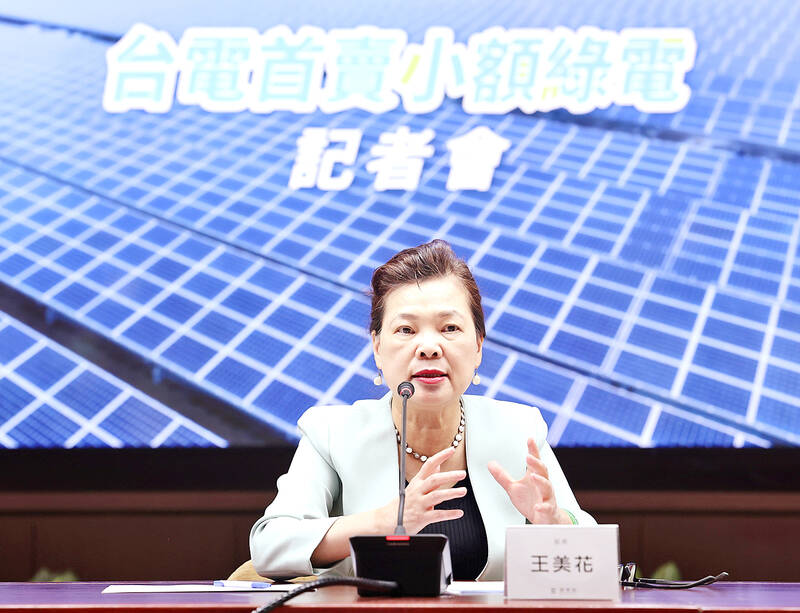State-run utility Taiwan Power Co (Taipower) is soon to begin selling small amounts of green power to small and medium-sized enterprises (SMEs) in Taiwan to help them meet the need for carbon reduction demanded by their clients, Minister of Economic Affairs Wang Mei-hua (王美花) said on Friday.
Taiwan’s exporters, many of which are part of global brands’ supply chains, are starting to feel the pressure to cut carbon emissions from clients’ intent on achieving net zero emissions by 2030, she said.
At present, big corporations are able to purchase renewable energy through corporate power purchase agreements — long-term contracts between renewable energy producers and buyers — yet SMEs have had trouble gaining access to those contracts, she said.

Photo: CNA
There has also been the issue of Taiwan simply not producing enough renewable energy to meet industrial demand, given the growing emphasis on reducing carbon emissions to address climate change.
Last year, Taiwan’s industrial sector consumed 56.1 percent of all electricity produced, but only 8.3 percent of all electricity produced was renewable, Bureau of Energy statistics showed.
To support the needs of SMEs, Taipower is to set up a renewable energy bidding platform that would offer 10 megawatt-hour and 50 megawatt-hour batches of energy from its own solar power installations for one-year, three-year or five-year periods.
The renewable energy would come from Taipower’s Salt-Field Solar Photovoltaic Power Plant in Tainan County and the solar farm in the Changhua Coastal Industrial Park, which generate roughly 300 gigawatt-hour (GWh) of power a year, or about 3 percent of all the solar power Taiwan generated last year.
The bidding platform would be managed by the National Renewable Energy Certification Center.
It is to be the first time that Taipower sells renewable energy directly to end users, the ministry said, adding that until now, it has either purchased green energy from private producers or sent green energy that it generated to the grid without specified purchasers.
The pilot program is to begin by putting up a first batch of 10 GWh for bidding at the end of this month and a second batch in the middle of next month, Taipower spokesperson Tsai Chih-meng (蔡志孟) said.
Successful bidders would be able to claim the use of renewable energy starting next year, Tsai said.
The reserve price would be set at a price that takes the feed-in-tariff (FIT) rate — a guaranteed, above-market rate that the government offered for the development of renewable energy — for the renewable energy plants and other administrative fees into account.
That would amount to an estimated NT$4 to NT$5 per kilowatt-hour, Deputy Minister of Economic Affairs Tseng Wen-sheng (曾文生) said.
Taiwan’s Electricity Act (電業法) was amended in 2017 to allow green energy producers to sell green electricity to end users by having them reserve a certain amount of power transmitted via the grid.
In 2019, the Renewable Energy Development Act (再生能源發展條例) was amended to allow renewable energy producers to freely choose between the government’s FIT policy and selling directly to private buyers, as prior to the amendment, those who had signed FIT agreements were tied to the 20-year FIT policy.

An essay competition jointly organized by a local writing society and a publisher affiliated with the Chinese Communist Party (CCP) might have contravened the Act Governing Relations Between the People of the Taiwan Area and the Mainland Area (臺灣地區與大陸地區人民關係條例), the Mainland Affairs Council (MAC) said on Thursday. “In this case, the partner organization is clearly an agency under the CCP’s Fujian Provincial Committee,” MAC Deputy Minister and spokesperson Liang Wen-chieh (梁文傑) said at a news briefing in Taipei. “It also involves bringing Taiwanese students to China with all-expenses-paid arrangements to attend award ceremonies and camps,” Liang said. Those two “characteristics” are typically sufficient

A magnitude 5.9 earthquake that struck about 33km off the coast of Hualien City was the "main shock" in a series of quakes in the area, with aftershocks expected over the next three days, the Central Weather Administration (CWA) said yesterday. Prior to the magnitude 5.9 quake shaking most of Taiwan at 6:53pm yesterday, six other earthquakes stronger than a magnitude of 4, starting with a magnitude 5.5 quake at 6:09pm, occurred in the area. CWA Seismological Center Director Wu Chien-fu (吳健富) confirmed that the quakes were all part of the same series and that the magnitude 5.5 temblor was

The brilliant blue waters, thick foliage and bucolic atmosphere on this seemingly idyllic archipelago deep in the Pacific Ocean belie the key role it now plays in a titanic geopolitical struggle. Palau is again on the front line as China, and the US and its allies prepare their forces in an intensifying contest for control over the Asia-Pacific region. The democratic nation of just 17,000 people hosts US-controlled airstrips and soon-to-be-completed radar installations that the US military describes as “critical” to monitoring vast swathes of water and airspace. It is also a key piece of the second island chain, a string of

The Central Weather Administration has issued a heat alert for southeastern Taiwan, warning of temperatures as high as 36°C today, while alerting some coastal areas of strong winds later in the day. Kaohsiung’s Neimen District (內門) and Pingtung County’s Neipu Township (內埔) are under an orange heat alert, which warns of temperatures as high as 36°C for three consecutive days, the CWA said, citing southwest winds. The heat would also extend to Tainan’s Nansi (楠西) and Yujing (玉井) districts, as well as Pingtung’s Gaoshu (高樹), Yanpu (鹽埔) and Majia (瑪家) townships, it said, forecasting highs of up to 36°C in those areas